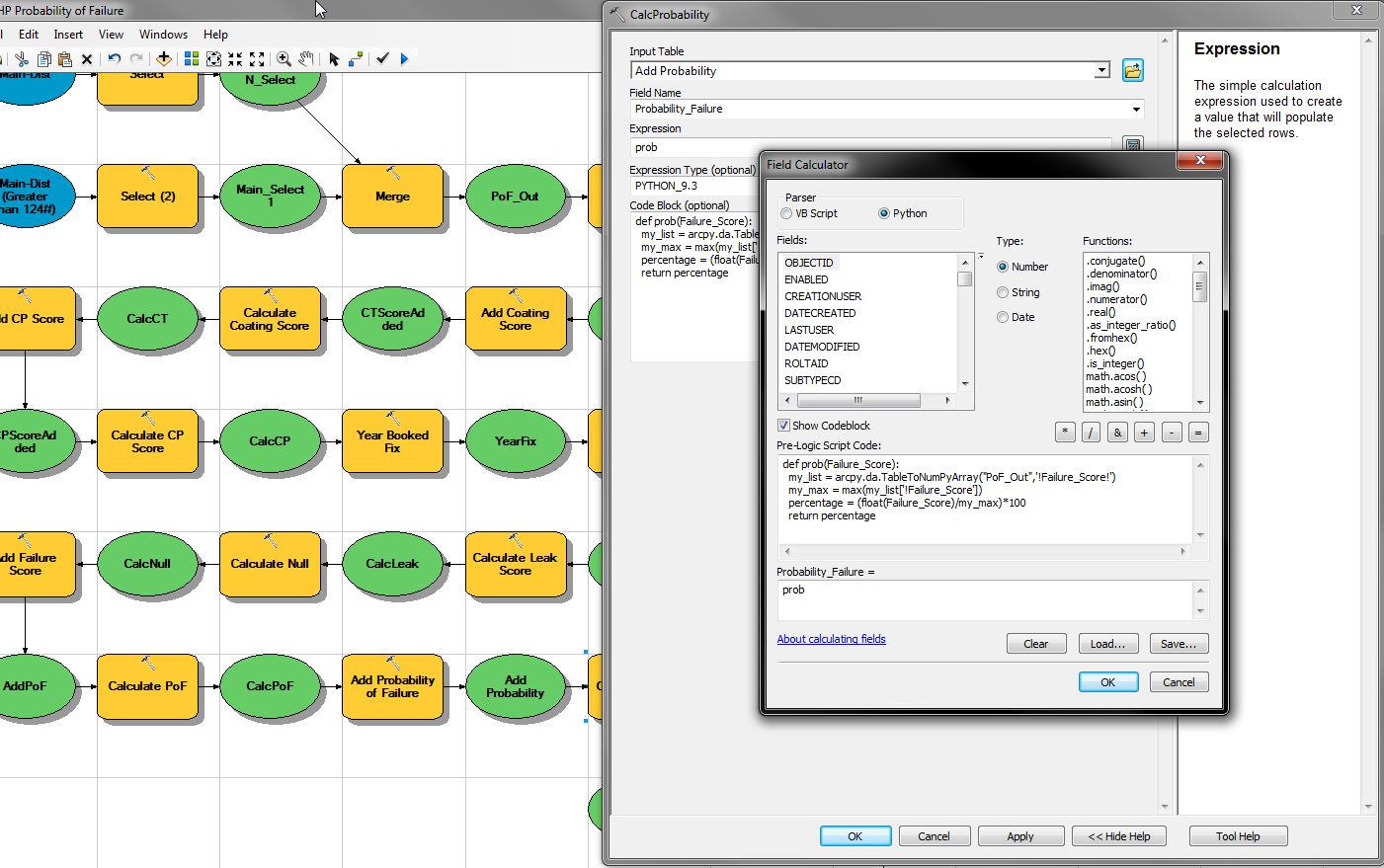- Home
- :
- All Communities
- :
- Products
- :
- Geoprocessing
- :
- Geoprocessing Questions
- :
- Re: Is there a way to get the maximum value of a c...
- Subscribe to RSS Feed
- Mark Topic as New
- Mark Topic as Read
- Float this Topic for Current User
- Bookmark
- Subscribe
- Mute
- Printer Friendly Page
Is there a way to get the maximum value of a column in Field Calculator?
- Mark as New
- Bookmark
- Subscribe
- Mute
- Subscribe to RSS Feed
- Permalink
I want to have a function in my model that converts an arbitrary value to a percentage within that column's range. It would need to be dynamic. Right now I have:
def prob( Failure_Score 😞
my_list = arcpy.da.TableToNumPyArray ("Failure_Score")
my_max = max(my_list)
percentage = (Failure_Score / my_max)*100
return percentage
but it returns nothing. Really any advice would be greatly appreciated.
Attached is a screencap with the two fields in question and the Calculate Field window.
Thanks!
- Mark as New
- Bookmark
- Subscribe
- Mute
- Subscribe to RSS Feed
- Permalink
So using the regular Field Calc like I've been, I've tried substituting everything I could think of into this equation. I may just leave it at using a static number as the max for now.

- Mark as New
- Bookmark
- Subscribe
- Mute
- Subscribe to RSS Feed
- Permalink
the expression box says ... prob ... you have to provide the field name !thefieldname! in ! marks
- Mark as New
- Bookmark
- Subscribe
- Mute
- Subscribe to RSS Feed
- Permalink
Here is a working example with my feature class and field names. Pay very close attention to where there are (and aren't) exclamation points.

- Mark as New
- Bookmark
- Subscribe
- Mute
- Subscribe to RSS Feed
- Permalink
You can put Summary Statistics tool and operate this for your field to get maximum value , then you can get this value by using Get Field Value tool , and use this Value in your expression.
if you put the tools in correctly way, the value will be generate dynamically each iteration
- Mark as New
- Bookmark
- Subscribe
- Mute
- Subscribe to RSS Feed
- Permalink
I think the best way to do this Model Builder is to use Calculate Value to find the total number (or Summary Statistics connect to Get Field Value) and then pass that into your function inside Calculate Field.
- Mark as New
- Bookmark
- Subscribe
- Mute
- Subscribe to RSS Feed
- Permalink
Here's a very fast way to get that maximum value:
Calculate Field
Expression
cfmax(r"%Input table%", "%Field%")
Code block
def cfmax(tbl, fld, where_expr=""): return sorted(arcpy.da.SearchCursor(tbl, fld, where_expr), reverse=True)[0][0]
Data Type
Variant
- Mark as New
- Bookmark
- Subscribe
- Mute
- Subscribe to RSS Feed
- Permalink
That is a straight forward method to get the max, but not very fast (perhaps you meant fast, like, quick and dirty). The cursor is created, stored, and sorted for every row in the table. Move the cursor outside the function to run only once.
Example, using 120000 features:
Expression:
cfmax()Code Block:
def cfmax():
max = sorted(arcpy.da.SearchCursor("Pemberton_VRI", "POLYGON_AR"), reverse=True)[0][0]
return maxResult: I ended the process after 5 minutes. Never finished.
vs.
Expression:
cfmax()Code Block:
max = sorted(arcpy.da.SearchCursor("Pemberton_VRI", "POLYGON_AR"), reverse=True)[0][0]
def cfmax():
global max # may not be necessary
return maxResult: finished in 38s.
- Mark as New
- Bookmark
- Subscribe
- Mute
- Subscribe to RSS Feed
- Permalink
run your numpy incarnation now that you have the data Darren (ie the one with tabletonumpyarray outside of the def), I suspect most of the time will be on the conversion but it is hard to test field calculator nippets
- Mark as New
- Bookmark
- Subscribe
- Mute
- Subscribe to RSS Feed
- Permalink
This runs in about 40s, so similar to the cursor:
my_list = arcpy.da.TableToNumPyArray('Pemberton_VRI', 'POLYGON_AR')
my_max = max(my_list['POLYGON_AR'])
def cfmax():
global my_max
return my_max...and this doesn't get past 0% (a blue sliver did just appear in the progress bar after a couple minutes):
def cfmax():
my_list = arcpy.da.TableToNumPyArray('Pemberton_VRI', 'POLYGON_AR')
my_max = max(my_list['POLYGON_AR'])
return my_max
- Mark as New
- Bookmark
- Subscribe
- Mute
- Subscribe to RSS Feed
- Permalink
Thanks for running that Darren.
First incarnation is good, the second... as you know... it is doing the conversion to array for every record.... it would have been to watch memory during that one